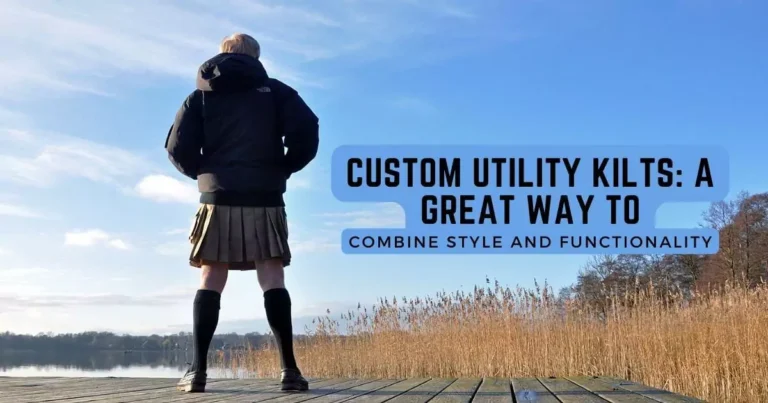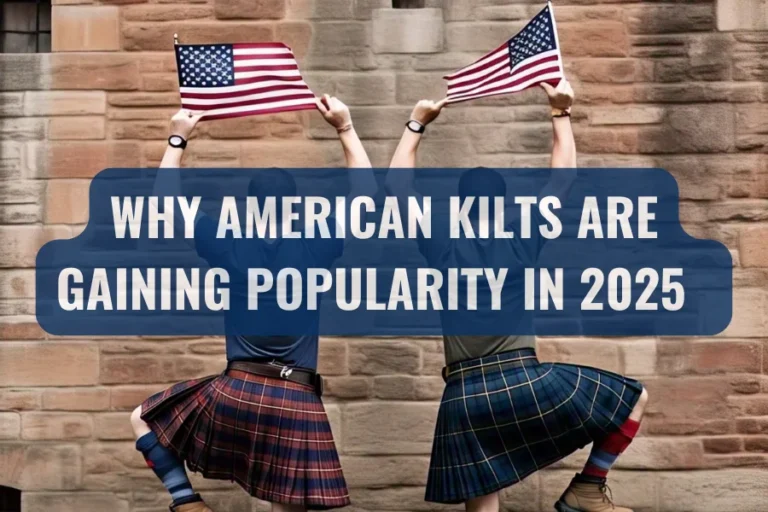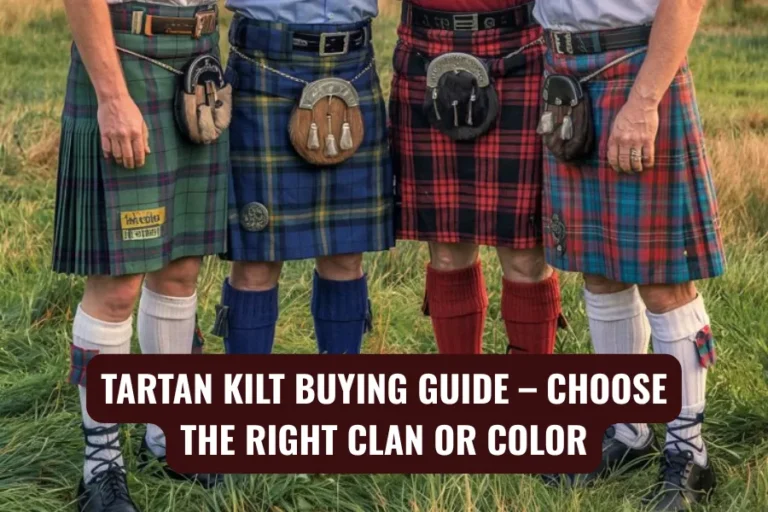Irish Kilts VS. Scottish Kilts: What’s the Difference?
At a glance, Irish and Scottish kilts can look… well, almost identical. Fabric wrapped around the waist, pleated in the back, tartan patterns, often worn with long socks and a sporran — it’s understandable why people get them mixed up. And, truthfully, if you asked someone walking down the street to spot the difference, chances are they’d just guess.
But if you start to pull at the threads — figuratively, of course — the two styles unravel into something much more nuanced. The thing is, it’s not just about how they look. It’s about what they mean. Where they came from. And how each one fits into the cultural identities of Ireland and Scotland in their own distinct, sometimes overlapping, ways.
It’s a subtle distinction. But it’s there.
The Origins: Two Histories, Parallel but Not Identical
Let’s start with the obvious — kilts are traditionally Scottish. That much most people agree on. The classic image of the Highland warrior, charging through misty glens in a full tartan ensemble, is deeply rooted in Scottish culture. Historical records show kilts being worn in the Scottish Highlands as early as the 16th century, especially the belted plaid — a large piece of cloth wrapped and belted around the body.
Irish kilts? That’s trickier. There’s debate about their origins, and not everyone agrees on when (or even if) they were traditionally worn. Some say they only really became popular in the early 20th century, especially around the time of the Gaelic revival — a cultural movement focused on reclaiming and celebrating Irish heritage. The kilt was adopted then as a symbol of national pride, especially among groups like the Irish Volunteers and pipe bands.
So, while Scotland has a long-documented tradition of kilt-wearing going back centuries, Ireland’s connection to kilts is more recent, more symbolic. Not lesser, just different.
Design Differences: Similar, But Not Quite the Same
Okay, so what does that actually look like?
Scottish kilts are usually made from specific clan tartans. These are registered patterns, with ties to family names, regions, or military regiments. You might hear someone say they’re wearing “MacDonald of Clanranald” or “Black Watch,” and those patterns often hold real personal or ancestral significance.
Irish kilts, on the other hand, don’t usually follow the same clan-based system. In fact, most are solid-colored — with saffron (a golden-yellow hue) being the most traditional. That said, modern Irish kilts do sometimes use county tartans. So, you might see someone in a “County Cork” or “County Mayo” pattern, but that doesn’t necessarily tie them to a family lineage the way Scottish tartans often do.
There’s a kind of openness to Irish kilt design. Less rigid. Perhaps even more expressive? But then again, the formality and structure of Scottish clan tartans can carry weight too. It depends what you’re drawn to.
Accessories: Where Details Speak Loudly
This is one of those areas where the difference is more noticeable — if you’re looking for it.
A Scottish kilt outfit is usually part of a larger traditional ensemble. Think Prince Charlie jackets, ghillie brogues, flashes on the socks, sometimes even feathered bonnets for formal occasions. It can get quite elaborate. And, honestly, it’s kind of impressive how much detail is involved.
An Irish kilt outfit tends to be simpler. Often paired with a plain jacket (like a Brian Boru jacket) or just a tunic-style shirt. Black or brown shoes, maybe knee-high socks, but fewer decorative elements overall. And instead of a sporran with a Celtic knot or animal fur — like you’d see in many Scottish outfits — Irish sporrans often feature a harp or shamrock, which quietly signals their roots.
One thing worth noting: saffron kilts (those solid gold ones mentioned earlier) are especially common in formal Irish pipe bands or ceremonial contexts. You’ll see them worn with high socks and tall capes, giving the whole look a bit of military flair. It’s striking, in a sort of stoic way.
Cultural Significance: Identity Worn on the Outside
Here’s where it gets a little more abstract. What a kilt means isn’t necessarily visible. And for many, it’s tied more to how it’s worn — and why — than to whether it’s plaid or saffron.
In Scotland, kilts carry a strong sense of ancestry. People wear them at weddings, ceilidhs, funerals, or during Highland Games — always with a sense of lineage and respect for tradition. There’s pride there, but also a kind of inherited belonging.
In Ireland, kilts have become a symbol of unity more than ancestry. They’re worn to express Irish pride, particularly in contexts where national identity is celebrated — St. Patrick’s Day parades, Irish dance competitions, cultural festivals. The symbolism is powerful, but it’s more national than familial.
Of course, some people wear them simply because they like how they look. Or they play in a pipe band. Or they’re part of a reenactment group. Or, maybe, they’re just curious. Not every kilt-wearer is a purist, and that’s okay too.
The Modern Revival: Style, Function, and Flexibility
These days, you’ll find kilts that defy both Irish and Scottish tradition altogether — utility kilts, leather kilts, hybrid styles that mix tartan with denim or canvas. They’re worn at Renaissance fairs, music festivals, and yes, even on casual Fridays in some shockingly relaxed workplaces.
And interestingly, both Irish and Scottish heritage communities have embraced this evolution. It’s not about replacing tradition — it’s about expanding what it can look like.
You’ll see Scottish families wearing Irish kilts. Irish musicians performing in Scottish tartans. And nobody’s getting too hung up about it. At least, most people aren’t.
Which, honestly, feels kind of human.
So… Which One Should You Wear?
It depends. And I realize that’s not a particularly satisfying answer, but it’s the truth.
If you have Scottish ancestry, you might feel drawn to a specific clan tartan. There’s something powerful about that — wearing your family colors, standing in the same patterns worn centuries ago. It’s more than a costume. It’s a statement, or a remembrance.
If you’re Irish (or just feel connected to Irish culture), a saffron or county tartan kilt might resonate more. It’s not about lineage — it’s about solidarity. National pride. That kind of thing.
But if you’re not from either background? That doesn’t necessarily mean you can’t wear a kilt. Just… maybe wear it with respect. Maybe learn a bit about where it came from, why it matters. Think of it less like a fashion piece and more like a small window into someone else’s history.
Or maybe you’ll wear it just because you like how it feels. There’s no waistband digging in. The air circulation is, honestly, phenomenal. That’s a perfectly valid reason, too.
Final Thoughts (Which Might Not Be Final)
Irish kilts and Scottish kilts aren’t the same — though yes, they’re closely related. One is grounded in ancient Highland history, deeply tied to family identity. The other is a more modern symbol of national pride, simple in appearance but no less meaningful.
They overlap. They diverge. And they’ve both changed over time, which is probably how it should be. Cultures evolve. Clothes evolve. Even traditions evolve — a little, sometimes reluctantly.
But the people wearing them? That’s the constant. They’re the ones carrying the meaning forward. Whether it’s through a perfect pleat or a mismatched sporran, a remembered story or just the decision to show up in a kilt at all.
In the end, maybe it’s not about what kind of kilt you wear.
Maybe it’s just about wearing it like it matters.









